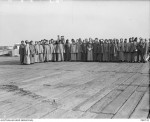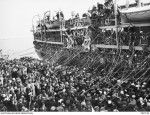McKINNON, Mary
Mary McKinnon (1885–1979) born in Marnoo, Victoria, the third of seven children born to Godfrey McKinnon (1847–1934) and his second wife Margaret (nee Patience) (c1851–1916).
Mary’s forebears on both sides were Scottish highlanders. Her father Godfrey had come from the Isle of Skye to Victoria as a young boy with his family, landing in Geelong in October 1852. The family (his parents and five children) had arrived with the assistance of the Highland and Island Emigration Society, which supported around 5,000 impoverished Scots seek new lives in the eastern colonies of Australia (see www.angelfire.com/ns/bkeddy/HIES/1.html). They farmed land near Mortlake.
Godfrey took advantage of the new availability of land under Victoria’s Land Act of 1865, buying property first in the Western District and then in Marnoo where the settlers were predominantly Scottish. He married Euphemia McKay in Warrnambool in 1874 and they had two children, one still born and one whose birth was followed a month later by Euphemia’s death in 1877.
In 1881, Godfrey married Margaret Patience (1850–1916), also living in Marnoo. She too had come to the colony as a young child, but her family were better off, unassisted immigrants. Her father James (1814–93), a boot maker from Ross-shire (1851 Scottish census), settled first in Geelong and then bought land around Beaufort, sometimes in conjunction with family members and in-laws. Margaret herself owned land in her own right when she married Godfrey as probate for her will showed.
Godfrey and Margaret had two sons and five daughters in the decade between 1882 and 1892. Godfrey steadily increased his land holdings by purchase, rent and licence, and Margaret retained her own property. The children were presumably educated in the local Marnoo public school, and the family was active in the local Presbyterian church. Godfrey was appointed the postmaster in 1886.
Nurses by the name ‘McKinnon’ were not unusual in Victoria from Mortlake to St Arnaud to Bendigo, presumably related in varying degrees of closeness from siblings to distant cousins. In becoming a nurse then, Mary was likely following a family pattern. She trained for three years at the hospital in St Arnaud forty kilometres from Marnoo, completing its certificate in July 1911, and several months later met the requirements for the Royal Victorian Trained Nurses Association. She subsequently worked as a sister both at the Adelaide Hospital and the Ballarat Hospital.
War Service
Mary McKinnon joined the Australian Army Nursing Service (AANS) in July 1915. Her motives must be surmised: neither of her brothers had enlisted nor did they subsequently, but perhaps some of her close and distant cousins had. Senior staff at Adelaide Hospital were she worked for a year before the war were pioneer army nurses and perhaps had made an impact, as had perhaps colleagues at Ballarat Hospital. She had too lived away from Marnoo, indeed in another colony, suggesting an independent mind-set.
On the embarkation roll for July 1915, her address was “East Melbourne, Victoria” (probably one of the trained nurses’ homes/depots) and her father as her next of kin.
Mary McKinnon and a local would-be soldier were given a ‘rousing send-off by their friends’ at the Marnoo railway station (Stawell News and Pleasant Creek Chronicle, 15.7.1915, p. 3). It was reported that she was going straight to the front. Her photograph was also published in Punch, 29.7.1915, p.21 (to come).
McKinnon sailed for overseas on 17 July 1915 on HMAT Orsova with a number of nurses allocated as reinforcements to 2 Australian General Hospital in Cairo, Egypt. Among them were Olive Haynes whom Mary may well have known at the Adelaide Hospital, and Catherine (‘Kit’) McNaughton, whose account of the voyage and her wartime service has been wonderfully recounted in Janet Butler’s biography, Kitty’s War: The remarkable wartime experiences of Kit McNaughton (UQP, 2013).
From Kit’s diary emerges the magnitude and horror of the deluge of casualties from the Gallipoli campaign that confronted her, Mary McKinnon and the other nurses. The nurses had never seen either the volume of patients nor the type of injuries (Butler, Kitty’ War, Ch.2).
Mary McKinnon’s stint at 2 AGH was short-lived, because she returned to Australia on transport duty on the ‘Kanowna’, arriving on 22 November 1915. ‘Kanowna’ carried several hundred Australian troops being repatriated back because of injury and illness (such as typhoid and diphtheria), loaded from London, Port Said, Suez, Alexandria and Malta. As the press noted, it was the first time wounded men had been transported in appropriate facilities – ‘as far as possible the conditions pertaining in a modern hospital are reproduced’ (Australasian, 27.11.1915, p.35). Three men had died on the voyage and the stretcher cases were off-loaded in Melbourne. The Argus reported on the ship in detail (Argus, 23.11.1915, p.6).
It was a quick turn around for Mary. A month later she left Sydney, again on the ‘Kanowna’ (No. 2 Hospital Ship), as part of the Hospital Transport Corps with its complement of sisters, nurses, masseuses and probationary nurses. The ship was also laden with comforts for the troops donated by the Red Cross and other agencies.
Mary was on the Kanowna’s return voyage which reached Australia in March 1916. Once again, its arrival excited public interest and was widely reported. The Melbourne press described a deceptively happy scene: ‘the soldiers looked happy and contented as they were driven through the cheering crowd which lined the city streets’ (Argus, 11.3.1916, p.17).
Just as the scene belied the soldiers’ conditions, so did hospital transport duty belie the dangers for the ships, their crews and their passengers. Being painted prominently as a hospital ship did not guarantee safety from enemy attack. Mary had made three return trips between Egypt and Australia in nine months.
Her second tour of duty on the Kanowna was to be her last. After three weeks leave, she returned to ‘home service’ and spent the remainder of 1916 nursing returned soldiers in two army hospitals in Melbourne, initially No 5 in St Kilda Rd and then No 11 in Caulfield. During this time she was promoted to the rank of Sister.
There were family reasons for remaining ‘at home’, among them her elderly mother who became ill and died in October 1916.
The real reason however was Mary’s romance with Raymond Francis Lynch (1892–1955), whom she had met on her first trip on the ‘Kanowna’ in 1915. Ray was the ship’s purser, an employee of the shipping company that owned the ‘Kanowna’, whose usual waters were along the eastern seaboard of Australia. He was seven years her junior.
According to her service record, Mary ‘resigned to be married and left Hospital on 30.12.16’. Her mantle was taken up, as it were, by her youngest sister Hughina who served as a nurse ‘on home service’ after completing her qualifications at Bendigo Hospital in 1917. (Hughina subsequently married the Revered Alexander Brodie, the local minister at Rupanyup/Marnoo.)
After War Service
Mary and Ray married in early 1917, and Ray apparently transferred to shore duty as a clerk. They had one child, Margaret Catherine. They lived in Melbourne for a time in the depression, but by the 1940s resided in Vaucluse in Sydney where Ray’s occupation on the electoral roll was ‘mariner’. By 1954, Ray and Mary had moved to Moss Vale, and Ray was a ‘merchant’. He died in 1955.
Mary lived another twenty-four years after Ray’s death, dying on 29 March 1979. They are both buried in the Bong Bong Cemetery near Moss Vale. (http://www.hawkesbury.net.au/cemetery/southern_highlands/bong_bong/bbpc316.html)
The names of Mary and Hughina McKinnon head the roll of those from the district who served recorded on the Marnoo Soldiers Memorial Park Gates dedicated in 1924.
Janet Scarfe, Adjunct Research Associate, Monash
18 July 2014
Can you help?
Can you correct or provide more information about this person?
Or are you able to help with this history project?
- Family stories and records including photos, documents and memorabilia?
- Stories or information in books, newspapers and on-line?
- Memorial plaques in churches and public places?
- War memorial, church, national and state archives?
If so, please Contact the East Melbourne Historical Society.


